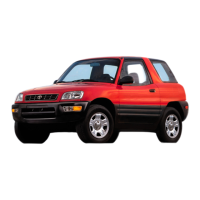’99 Rav4.U
157
Part 4
IN CASE OF AN
EMERGENCY
If your vehicle will not start
If your engine stalls while
driving
If your vehicle overheats
If you have a flat tire
If your vehicle needs to be
towed
If you cannot shift automatic
transmission selector lever
If you lose your keys
Before making these checks, make sure
you have followed the correct starting pro-
cedure given in ”How to start the engine”
in Part 3 and that you have sufficient fuel.
If the engine is not turning over or is
turning over too slowly—
1. Check that the battery terminals are
tight and clean.
2. If the battery terminals are O.K., switch
on the interior light.
3. If the light is out, dim or goes out
when the starter is cranked, the battery
is discharged. You may try jump start-
ing. See ”(c) Jump starting” for further
instructions.
If the light is O.K., but the engine still will
not start, it needs adjustment or repair.
Call a Toyota dealer or qualified repair
shop.
NOTICE
Do not pull- or push- start the vehicle.
It may damage the vehicle or cause
a collision when the engine starts.
Also the three- way catalytic converter
may overheat and become a fire haz-
ard.
If the engine turns over at its normal
speed but will not start—
1. Check that all the push- on connectors
are tight. (For example, connections at
the spark plugs, ignition coil and/or dis-
tributor)
2. If the connectors are O.K., the engine
may be flooded because of repeated
cranking. See ”(b) Starting a flooded
engine” for further instructions.
If your vehicle will not start—
(a) Simple checks

